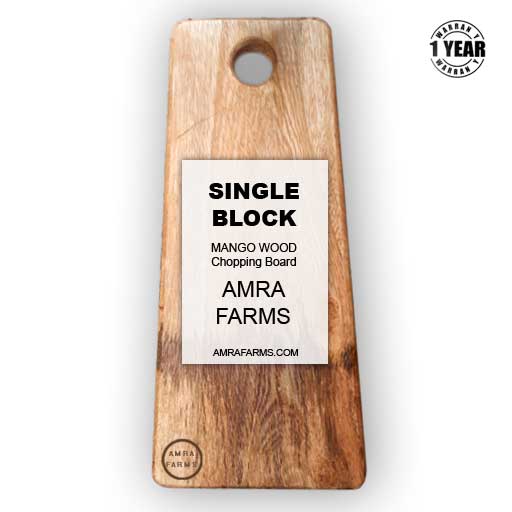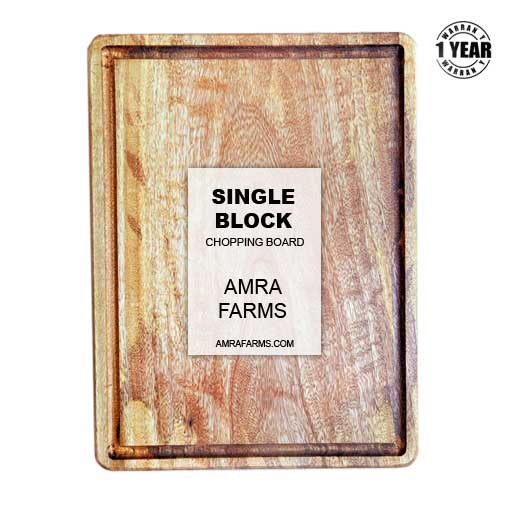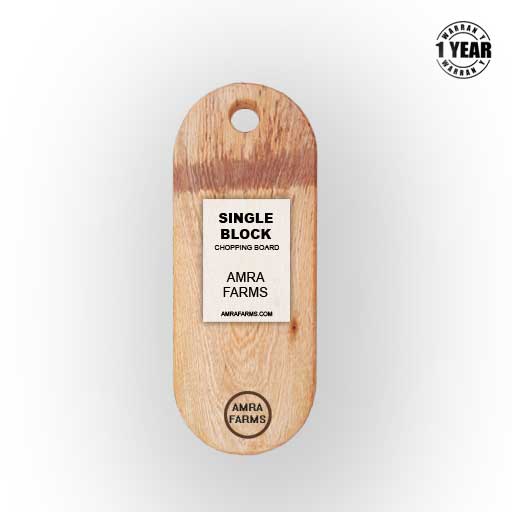Single Block Wooden Vegetable Chopping Boards
Our Single Wood Cutting Board is crafted from a single slab of wood. Available in a rectangular shape, these wooden kitchen boards are made from mango wood or teak. Durable for meat cutting, vegetable preparation, and bread slicing, the multipurpose cutting surface is perfect for professional chefs. Our boards are knife-friendly, non-toxic, and food-safe. The natural wood grains of teak wood and the rustic charm of mango wood make them a great choice for an eco-friendly kitchen.
FAQ
What type of wood is best for a vegetable chopping board?
A type of wood for a vegetable chopping board depends on your usage. If you cook regularly, you would want a chopping board that is light, easy to handle and yet strong. Mango wood is light and perfect for regular use. Teak wood is durable, looks beautiful but slightly heavier. This is a perfect choice for people who don’t mind handling a heavy chopping board. Also, if your kitchen is large, we recommend a Teak wood vegetable chopping board + a Mango wood chopping board to balance between various vegetables you cut.
Are wooden chopping boards safe for vegetables?
Yes. Wooden chopping boards are the safest boards to cut vegetables. They are naturally antibacterial, self-healing and look beautiful without any chemicals or toxins. Plastic is probably on the bottom of the list due to the health hazards it brings, while glass and steel are prone to accidents in the kitchen. Wood is durable, natural and the time-tested option to chop vegetables in a home kitchen.
Can I wash a wooden chopping board in the dishwasher?
No. Wooden chopping boards are not dishwasher safe. This is probably the only drawback of a wooden vegetable chopping board. Wooden chopping boards will bloat, warp and crack if exposed to too much heat and water. Avoid using a dishwasher to clean your wooden chopping boards. We recommend a thorough hand wash with mild soap for a clean chopping board.
How do I clean and maintain my wooden chopping board?
Cleaning our wooden chopping boards is easy. Ensure that there are no food particles stuck to the board. Use the back of your knife to scrape off food particles stuck to the board. Use a mild soap if required and rinse the board thoroughly in warm water. Once you wash the board, dry it with a towel and let it stand vertically to ensure proper ventilation.
How often should I oil my wooden chopping board?
We recommend you oil your board at least once a month or when your board feels dry. Use coconut oil or mineral oil with beeswax to oil your board. When possible, apply oil overnight and let it soak in the oil. Wipe the excess oil in the morning. This ensures the oil soaks into the board providing the extra water resistance required.
Are wooden boards more hygienic than plastic ones?
Wood is definitely better than plastic in terms of quality and functionality. Plastic comes with a lot of health hazards. They tend to accumulate bacteria over the course of time. Wooden boards are naturally self-healing and prevent bacterial growth. They are organic and do not have any side effects on your health.
Can I use one board for both vegetables and meat?
Yes, you can use one board for both vegetables and meat provided you use one side for meat and the other side for vegetables to prevent cross-contamination. Our boards are reversible allowing you to use both the sides. This ensures you need only one board for both tasks.
What size board is best for chopping vegetables?
The size of the board depends on your kitchen. Most families will require a medium-sized board which is 12-15 inches long and 9-12 inches wide. The height of the board should be at least 2 centimeters to prevent warping and cracking. If you are cooking for a large family, we recommend a board which is 18 inches long and 12 inches wide. The thickness of the board should be at least 1 inch.
How long will a wooden chopping board last?
Mango wood will last approximately 4-5 years if cared for. Teak wood will last 8-10 years with proper care. Ensure that your wooden chopping boards are oiled regularly, kept dry and clean for a longer life. Teak wood boards require less care than mango wood and last a lot longer.
Can I sand my wooden board if it becomes rough or stained?
Yes. You can sand the board every 6 months to ensure the board looks new, clean and free from knife marks and scars. Also, sanding ensures that the board does not develop an uneven surface. If you are an ardent chef with more cutting tasks, sand the board when it has too many knife scars. Don’t be shy to sand your board. Sanding only improves the quality of your board and the looks too. Remember to oil your board generously after sanding.
Is a wooden board bad for knives?
Wooden board, on the contrary, is one of the best materials for knives. They are safer than plastic, steel, glass and bamboo. Your knife’s sharpness will be maintained for a longer span than when you use other material.








